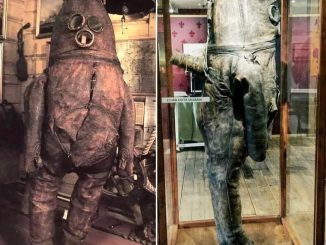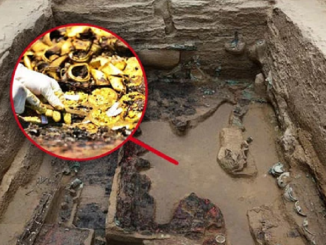THE LADBY VIKING SHIP
In 1935, the remains of a Viking ship burial were discovered at Ladby right next to Kerteminde fjord in Denmark. This was not an ordinary ship, but a warship of almost 22 meters in length and three meters in width, with room for 32 oarsmen.
Just like the burial mound at Gjellestad and many other places, the burial mound at Ladby had also been destroyed long ago by plowing. The majority of the Viking ship had also decayed, but there were still bits and pieces of the wood left, so we know that it was made of oak and that it was built around 925 CE.
Because of its condition, the ship was left at the location, and only the most valuable objects were removed from the grave. But a new burial mound was built around it, and the ship was encapsulated in order to preserve it.
INSIDE THE VIKING KING’S TOMB AT LADBY
I find it remarkable that somehow the shape of the Ladby ship is still visible after 1100 years, and I was filled with all kinds of emotions while being in its presence. But it is kinda hard to explain how it feels to be alone inside a dark tomb right next to the remains of an ancient ship.
It was not completely silent, but it felt like the world was set on pause for a few moments, and I only wish that I could have shared the experience with someone.
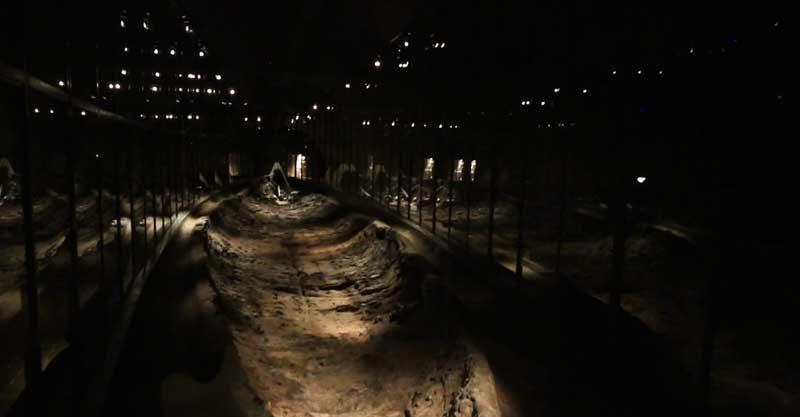
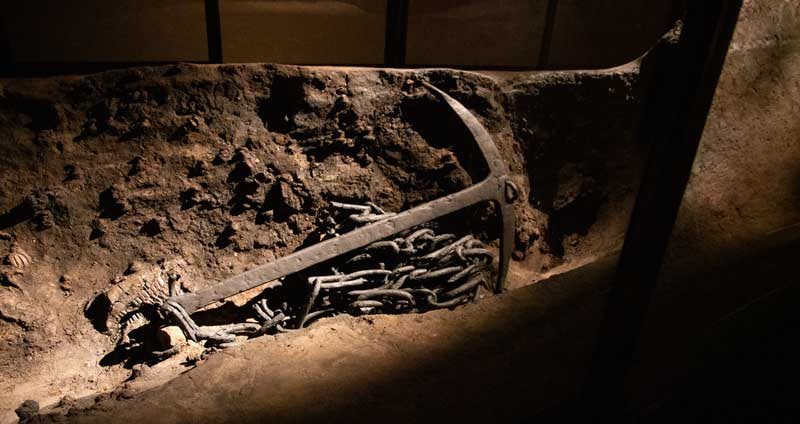
The skeletons of the eleven horses and four dogs that accompanied the deceased into the afterlife are still laying in the same spot where they were sacrificed. There is also something truly unique that you don’t really see from these graves, and that is this big anchor. This anchor is made of iron and it has an iron chain that is approximately 15.5 meters, and it looks to be in such good condition that it could probably be used today if we wanted to.
Most Viking ships had, of course, also an ornament in front of the ship, and in this case, it is believed that it was some kind of dragon head. The dragon head was decorated with iron curls, but the ones in the tomb are just the replicas, the originals are being preserved inside the museum along with the spikes from the dragon tail.

The horses in the grave are of the same kind as what we today would call Icelandic horses, these small horses have a natural resilience to harsh weather conditions, which is probably why they thrive so well in the Icelandic climate.
THE KING HAD A UNIQUE DOG LEASH
The four dogs were very different from each other. Two of them would have looked a bit like the sled dogs from Greenland. The third was a lot bigger, perhaps a Broholmer or a race very closely related to it. The fourth dog was the smallest of them all, and it can best be described as a Fox Terrier. They are all hunting dogs, but having three different kinds of dogs is probably an indication that this person loved dogs.

The dogs were buried with a unique dog leash made of leather with ornaments in bronze with gildings. These ornaments were also part of dating the burial because these patterns were part of the hottest fashion during 920-940 CE.
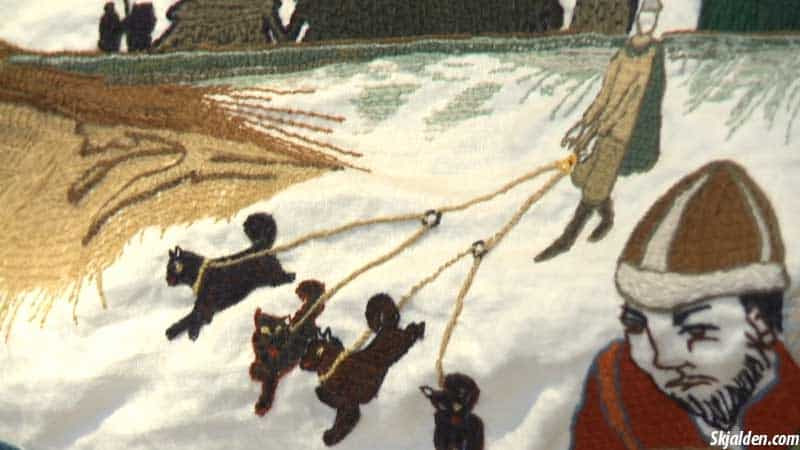
Something that also makes this dog leash very unique, is that the King could have controlled all of the dogs at the same time, and perhaps he even used the leash when he was out and about walking his dogs in the nearby area.
The researchers are quite certain that this was how the Ladby ship looked like. But many of the details are qualified guesses based on previous findings. This is a replica, and it was built by using the same kind of tools and techniques as they did in the Viking Age.

VIKING SHIPS WERE COLORFUL
As you already may know, the Vikings loved colors, and we know that the colors of this ship were blue and yellow, and perhaps that was the colors that the clan was using. We know without a doubt that all the Viking ships had colors, and there have been found plenty of examples of this from excavations.

The Viking ships are also portrayed as being colorful on the Bayeux Tapestry, so we are quite certain that they were colorful, and they definitely did not look as they have been portrayed on the history channel, or on the Netflix show Vikings: Valhalla.
But one of the questions that have haunted the archeologists for centuries is, who was the person? Of course, there was no question about the status of the individual, because only the rich and powerful Kings and Queens could afford a lavish burial like this.
As mentioned before, the archeologists had come to the conclusion that the burial must have taken place around 925 CE, and this is actually an interesting time in history because this was about 30-40 years before the famous Harald Bluetooth united Denmark and Norway into one Kingdom.
The mound itself is also located at an interesting place, and it was probably no coincidence why this exact spot was chosen. The mound is located right next to Kerteminde fjord which is connected to the Great Belt from where merchants could arrive with their goods and sell them at the local market.
But there is a problem with that theory. Ladby is not known for being a trade town, nor has there been found anything that could look like a market in the area, so what could have been so special about this place?
DID THE KING PROVIDE A SAFE HARBOR?
One of the theories is that the King made a fortune by providing a safe harbor for the travelers. They could either have come here to rest for the night or wait for a storm to pass. It is also possible that merchants could seek refuge if they were pursued by hostile ships.

It would have been easy for the King and his men to defend against a fleet of ships, not only is the entrance to the fjord very narrow but there would also have been a maze of wooden beams submerged in the water.

So even if hostile ships were to defeat his men at the entrance to the fjord, they would have a hard time advancing if they didn’t know where the beams were located. And even if they somehow knew where it was safe to sail, they would still have to sail in a predetermined route, which made it easy to defend.
This would also have significantly slowed down the ships that were approaching which would have given the King and his men enough time to react to unwanted guests. So unless the visitors were friendly and paid for their passage, they would have had a hard time sailing into the fjord.
But just because you sail into an inlet does not mean that the hostile ships will disappear, they could still have waited along the coast for them to return. But the King could have offered an additional service to the traveling merchants because further inland is the village Dræby.

The word Dræby means (Danish: “Stedet hvor man drager”), “The place to go”, and this name could be an indication that many people come here. The locals could then have made a living by emptying out the stones of the ships, and dragging them 800 meters across until they reached Odense Fjord on the other side. Once the ship was safely in the water again, they could have filled the ships with the same amount of stones again. Which they would already have stored there.
You may not know this, but many of these ships used stones to prevent them from tipping on their side. So unless you were traveling with a lot of goods, there would always be a few tons of stones in the bottom of the ship.
The King would probably also have had a few warships in Odense fjord, and it is possible that they accompanied the merchants out to the open sea, to make sure that it was safe to keep traveling to one of the trade towns such as Aros in Jutland.
Dræby could also have been a trade town, or have had some kind of importance due to its name, but there has not been found anything to suggest this, at least not so far.

The King at Ladby could also have earned his riches with the sword, and he could have had close ties with the King at Tissø, an old village that is located just across The Great Belt on the island of Zealand. It is possible that these two clans raided together in foreign lands, or perhaps they were just in a defensive alliance against hostile invaders. But it was probably these two clans who controlled The Great Belt between Funen and Zealand.
Regardless of whether he was a warmonger or if he earned his fortune by providing a safe harbor, his funeral would probably have looked spectacular, and anyone who had a high social status would probably have been invited and expected to bring expensive gifts.
But the burial mound would not stand untouched for long, there are signs that someone already robbed the grave within one to two generations. Not only did they take everything of value, but they also removed the remains of the King. Why exactly his remains were removed is only something that the gods know, but we have two theories of what might have happened.
One theory is that it was his own family who opened the grave and removed his remains, so he could be buried at a local church. This would make perfect sense because the Christianization of Denmark took place during the reign of King Harald Bluetooth, and, therefore, his family would probably have wanted him to be moved to their family grave at a church.
Another theory is that it was the rise of the Jelling dynasty that resulted in his grave being plundered. If this was done in order to help Harald with funding his fortresses across Denmark, or perhaps because he wanted to erase the Ladby King from history is only something that we can speculate about today.
But the evidence does seem to suggest that the second theory could be what most likely happened. Because the grave was not just robbed, it was split apart, and many of the items were smashed to pieces. This is not an action of someone who is just there to steal the riches from the dead, but of someone who either had a hatred towards him or wanted to ease the history of the previous rulers in the area.
Erasing the past of another clan or society is a strategy that has been used many times before and it is a strategy that is still being used in some parts of the world today. I can think of a few examples, but I don’t want to be too political.
The Viking Museum at Ladby is an interesting place, and if you one day come to Denmark, then I would like to recommend this place. It is not the biggest museum in the world, but you can spend a couple of hours here.

I loved seeing the ships and the many objects, but it was very interesting to see the dog leash, it is not something that you really think about, so it is nice to see everyday items like these.
I would also like to highlight the tapestry that was made by a group of local women, who tried to capture the history of Ladby inspired by and by following the exact same technique as the famous Bayeux Tapestry from the 1070s CE.
